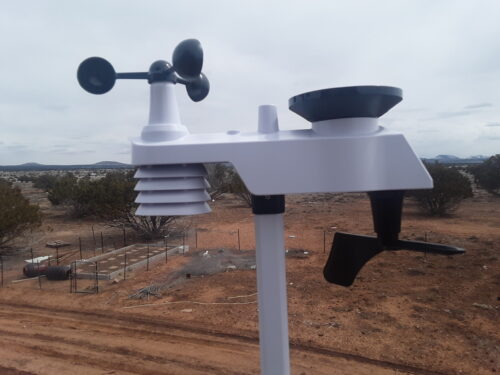
Hi, Phoenix here. In this post, I want to talk about weather monitors. When in the city and spending much of my time indoors, I didn’t need to check the weather very often. The news also had weather information specific to the city.
When I moved out to the homestead, though, I started relying pretty heavily on K’s weather monitor. News stations don’t really report on weather out here, which differs quite a bit from surrounding cities. When taking care of the animals, we need to know when it might rain or snow, when it’s below freezing, etc. Dressing appropriately for the weather is a matter of health, not just comfort, when doing homesteading chores.
I didn’t fully realize how dependent I had become on our weather monitor till K’s outdoor sensor stopped working after 10 years. We were completely lost till we got a replacement, not knowing what to expect when we stepped outside. We also don’t use a thermostat to control the indoor temperature, so maintaining a constant temperature with manual settings on the propane heater was challenging.
A weather monitor consists of an outdoor station with sensors, hooked up to an indoor display. The sensors measure things like temperature, humidity, barometric pressure, wind direction and speed, rainfall, etc. K started using weather monitors because if he knew the local temperature, humidity, and barometric pressure, he could tell when a storm was coming. He could also track annual patterns to figure out the best times to plant and harvest.
To do this yourself, here is the simplified description K provided. First, you need to know what the normal barometric pressure, or the density of air, is for your area. In situations of low pressure, moist storm clouds will settle into the dip formed by the low pressure system. In situations of high pressure, storm clouds are more likely to be deflected to other areas. So, if the barometric pressure is increasing, there’s a chance you’ll have good weather for a while. If it starts going down, there’s a possibility of a storm.
For a better idea of when a storm is coming, you can also track the dew point and humidity. Dew point is the temperature at which atmospheric moisture condenses to liquid. If the dew point increases and gets close to outdoor temperature, there will likely be a storm. Humidity is the percent moisture in the atmosphere, which is at maximum 5% of the atmospheric composition. In weather reports, we usually see relative humidity, which is relative to that 5% maximum. So, 100% humidity would translate to 5% actual humidity in the atmosphere. Higher than normal relative humidity usually means a storm is coming. Wind speed can result from air cooling down and sinking lower in the atmosphere and/or air warming up and rising. It doesn’t directly indicate an approaching storm, although warm air colliding with cold air may cause a storm. These observations help K plan out his chores. For example, he can avoid doing outdoor electrical tasks, like hooking up solar panels, when it’s about to rain.
With the climate changing, though, we’ve seen drastic changes in our local weather patterns. This makes it extremely difficult to plan out a timeline for our annual chores. Last winter was wetter than normal, which although inconvenient at times, helped replenish the groundwater. This winter has been even wetter, and we’re glad to have the water. The constantly wet roads, however, have made trips to town more challenging. We’re also seeing more variation in temperatures, with one or two sunny days followed by a week of rain and snow off and on, followed by another one or two sunny days. This has delayed several of our projects.
We’ve also noticed the range in barometric pressure has drastically increased, with much higher pressures and much lower pressures than K had seen ten years ago. The range has been increasing dramatically over the past 3-4 years. Nowadays, we’ve seen storms develop even at higher pressures than in the past. We’ve also noticed barometric pressure plummeting lower than before during storms, making them more intense. K has seen rain at lower relative humidity than before, again delaying planned projects.
I wonder whether these patterns will continue to change or whether this is the new normal. Stay tuned.
Next blog post: Springtime on the homestead–baby animals (by Phoenix)
